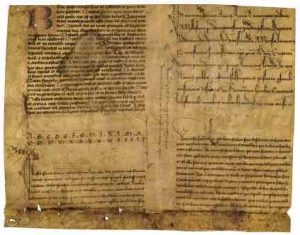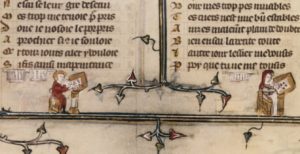
Herman Strepel’s Advertisement sheet for scripts, c. 1450 (The Hague, KB, 76 D 45) – Image: medievalbooks.nl
It was a slow day in 1450 and Herman Strepel, a scribe in Münster, Germany, was bored. With the last manuscript almost complete, he needed a new client. So, his eyes lit up when a passerby stepped into his store. His clothes spoke of a wealthy merchant. Perhaps even a member of the aristocracy, although Herman would have probably recognized him. The man stopped to gaze admiringly at the wall, where an advertisement sheet hung, showcasing samples of Herman’s versatile handwriting. Much like every other scribe in the city, Herman had been using such posters to cover his walls and part of the window, in order to entice clients into ordering.
He walked next to the potential client and pointed at a script name, written in appealing golden letters. “We have two categories of letters.”
The man nodded. “Do say.”
Emboldened by the response, Herman continued. “Firstly, the shape of these letters differs because they belong to different script families. Secondly, the precise execution varies because each scribe opts for a particular size, thickness, quality, and pen angle.” He pointed at three samples. “Take for example the three major script families from our past: Caroline minuscule, Pregothic, and Littera textualis – also known as Gothic script. The first was used between 800 and 1050; the second between 1050 to 1250. The third one has been in fashion ever since.”

Three medieval script families: St Gall, Stiftsbibliothek, 14 (9th century); Leiden, University Library, BPL 196 (12th century); London, British Library, Arundel 28 (13th century) – Image: medievalbooks.nl
“So you can tell when a book has been written merely by studying the font used?” the man asked, his voice betraying his surprise.
“Indeed,” Herman said proudly. “If you know how the font evolved over time, you can pinpoint the decade during which it was produced.”
The man leaned closer, squinting to study the letters. “I don’t notice much of a difference.”
“Ah, you have to know what you’re looking for.” Herman pointed at a word. “Take the letter pair de. Here are two elements of this letter pair, which was written down in 1156 or 1157. See how they’re touching one another, albeit only slightly? Just twenty years earlier these same letters would still have been written fully separated.”

Letter pair “de” in Charleville, Bibliothèque municipale, Ms 246 B (dated 1156-1157) – Image: medievalbooks.nl
“How interesting.”
Herman’s finger moved to another segment of the poster. “In fact, by the 1300s the pair has moved so close together that they share the central vertical pen stroke: the right side of d is also the left side of e. The two have literally become inseparable because separating them would leave one of them incomplete. Of course, as a book takes years to finish, even a single script feature needs time to spread to all corners of the script.”
“And you know all these scripts by heart?”
Herman’s chest swelled with pride. “A number of them, yes. Unlike the monks, who are by their very nature conservative, we commercial scribes can produce a range of fonts on command.” He beamed his best smile. “Now, can I interest you in a book?”
“You know,” the man said as he tapped his lips, “you may be just the man for the job. But I’m not looking for a book. I’m looking for a flyer to be posted in the city. Do you do these?”

Medieval advertising flyer. Oxford, Bodleian Library, Arch. G. e. 37 (c. 1477) – Image: medievalbooks.nl
Herman rubbed his hands together. “Of course! Let me show you some of my work…”
You can find out more on Medieval advertising posters and fonts on Erik Kwakkel’s Medieval books blog.







I am useless at calligraphy too, which just goes to show that there was a reason that only some people could be scribes. 😉
Cheers
MTM
Lol – tell me about it 😀
It’s artistic and painstaking but hard on the eyes. Interesting story, though. 😀
Thanks 🙂
You need a lot of patience… it is only akin of exercising. We are used to typing on the PC keyboard all time… is nowadays hard to write a letter by hand… but believe me, calligraphy is something marvelous! You need the right ink, several pen nibs… the good special paper… and you can start! It is a lot of fun and makes, for example, a lovely dedication when you sign your book for a buyer
Have a lovely day :-)claudine
Nice! Sounds very meditative. Thanks for sharing 🙂
Love this. I once bought a calligraphy set, and tried to learn to write using italics. I couldn’t get it at all though, just didn’t seem to have ‘The Hand’ for it.
Best wishes, Pete.
I’ve never tried it myself, but wouldn’t be surprised if I had the same experience as you. I seem to lack the patience for it 🙂